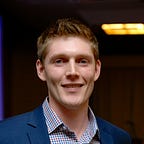Tanvas Cofounders Speak at National Academy of Engineering Symposium
Last week, Tanvas cofounders Ed Colgate and Michael Peshkin were invited to present a lecture on Surface Haptics at Northwestern University’s National Academy of Engineering (NAE) Public Symposium. The symposium, titled “The Networked Body” featured talks from top researchers innovating at the intersection of electronics and the human body. Representatives from high-performance organizations such as the U.S. Air Force and the Chicago Cubs also presented.
Professor Peshkin treated the room of distinguished engineers to a lesson about the long history of electrostatic haptic feedback which dates back to the 1870s when Elisha Gray discovered an interesting sensation involving electricity and a nickel bathtub. Gray would go on to advance the sensation into a method of reproducing sound and — according to a popular myth — lose a race to the patent office against Alexander Graham Bell to patent the telephone. Peshkin showcased videos of the most recent research to come out of the Neuroscience and Robotics Lab (NxR) which reproduces both haptics and sound simultaneously at the surface of the fingertip, essentially using the skin as the speaker.
Professor Colgate underscored the fundamental importance of the field of haptics by drawing a sharp contrast between the impressive things that people are able to do with the sense of touch, and the incredible difficulty of doing even simple tasks without the sense of touch. He showed a video from the lab of famous neuroscientist Dr. Roland Johansson of a woman attempting to light a match with anesthetized fingers. Before her fingers were numbed, she easily and naturally lit the match in a few seconds. After her sense of touch was removed through numbing, it took her several tries to pick up a single match, awkwardly grasp it, drop and pick up a new one, reposition it for lighting two or three times, and eventually strike it with apparent great difficulty. This was all in spite of the fact that the woman had full view of what she was doing, and she had no difficulty moving her fingers. Colgate voiced the reaction of the crowd, saying, “Oh, it is painful to watch.”
As a counterpoint, Colgate offered the complex, precise, and fluid movement of high performance athletes like Michael Jordan and Serena Williams, and a professional musician like Joshua Bell. He explained that their movements rely intensely on their ability gather and process information from the objects with which they are interacting, and he pointed out that not a single one of them are looking at their hands.
For me, the point was driven home by an image of students walking down the sidewalk staring at their phone screens while texting. With today’s interfaces, Colgate says “…the rich touch sensors have virtually no role,” seeming to suggest that our current interactions with touchscreens have more in common with the bumbling of anesthetized fingers than with the articulate motion of athletes and musicians.
About the NAE
Founded in 1964, the National Academy of Engineering (NAE) is a private, independent, nonprofit institution that provides engineering leadership in service to the nation. The mission of the National Academy of Engineering is to advance the well-being of the nation by promoting a vibrant engineering profession and by marshalling the expertise and insights of eminent engineers to provide independent advice to the federal government on matters involving engineering and technology.
The NAE has more than 2,000 peer-elected members and foreign members, senior professionals in business, academia, and government who are among the world’s most accomplished engineers. They provide the leadership and expertise for numerous projects focused on the relationships between engineering, technology, and the quality of life.
